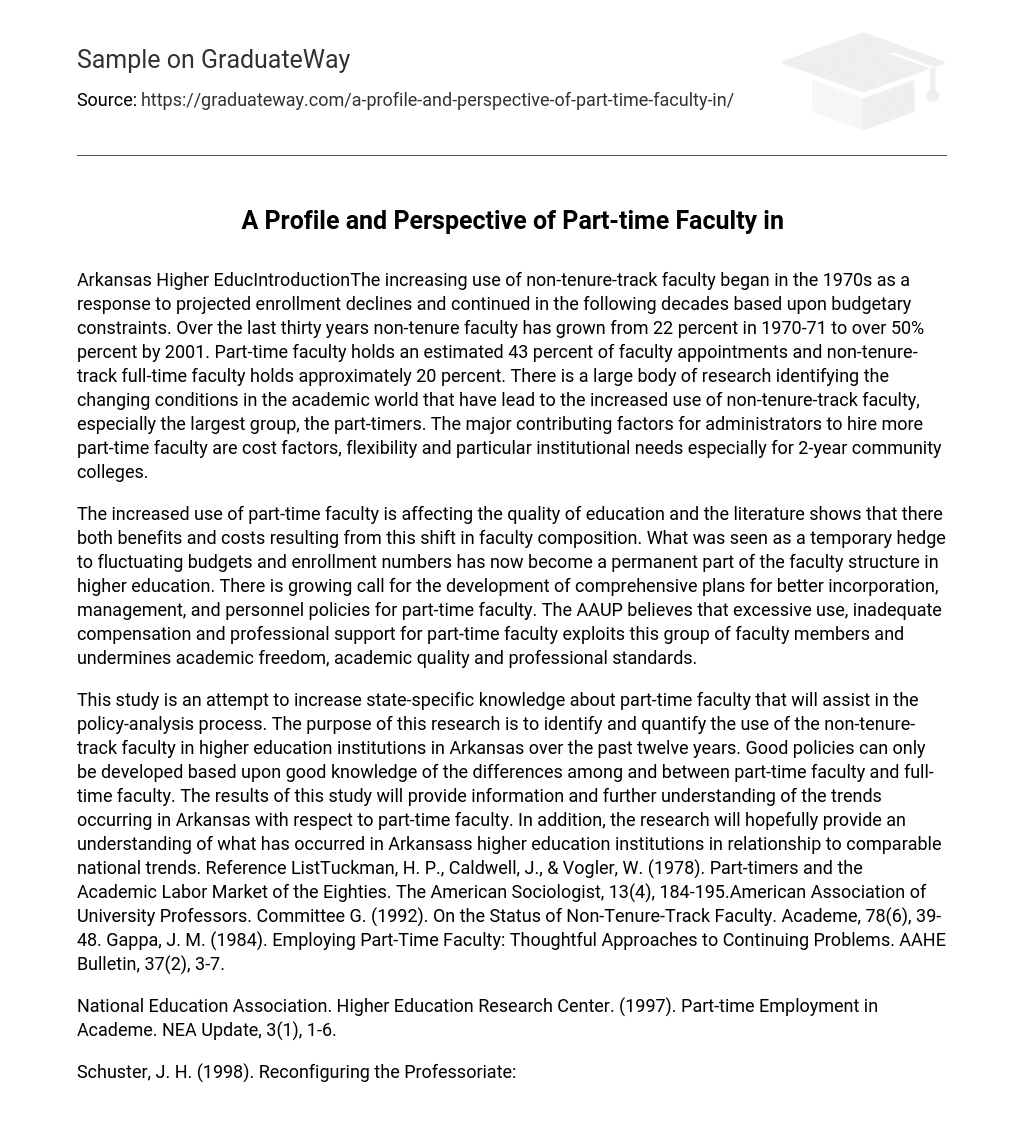Arkansas Higher EducIntroductionThe increasing use of non-tenure-track faculty began in the 1970s as a response to projected enrollment declines and continued in the following decades based upon budgetary constraints. Over the last thirty years non-tenure faculty has grown from 22 percent in 1970-71 to over 50% percent by 2001. Part-time faculty holds an estimated 43 percent of faculty appointments and non-tenure-track full-time faculty holds approximately 20 percent. There is a large body of research identifying the changing conditions in the academic world that have lead to the increased use of non-tenure-track faculty, especially the largest group, the part-timers. The major contributing factors for administrators to hire more part-time faculty are cost factors, flexibility and particular institutional needs especially for 2-year community colleges.
The increased use of part-time faculty is affecting the quality of education and the literature shows that there both benefits and costs resulting from this shift in faculty composition. What was seen as a temporary hedge to fluctuating budgets and enrollment numbers has now become a permanent part of the faculty structure in higher education. There is growing call for the development of comprehensive plans for better incorporation, management, and personnel policies for part-time faculty. The AAUP believes that excessive use, inadequate compensation and professional support for part-time faculty exploits this group of faculty members and undermines academic freedom, academic quality and professional standards.
This study is an attempt to increase state-specific knowledge about part-time faculty that will assist in the policy-analysis process. The purpose of this research is to identify and quantify the use of the non-tenure-track faculty in higher education institutions in Arkansas over the past twelve years. Good policies can only be developed based upon good knowledge of the differences among and between part-time faculty and full-time faculty. The results of this study will provide information and further understanding of the trends occurring in Arkansas with respect to part-time faculty. In addition, the research will hopefully provide an understanding of what has occurred in Arkansass higher education institutions in relationship to comparable national trends. Reference ListTuckman, H. P., Caldwell, J., & Vogler, W. (1978). Part-timers and the Academic Labor Market of the Eighties. The American Sociologist, 13(4), 184-195.American Association of University Professors. Committee G. (1992). On the Status of Non-Tenure-Track Faculty. Academe, 78(6), 39-48. Gappa, J. M. (1984). Employing Part-Time Faculty: Thoughtful Approaches to Continuing Problems. AAHE Bulletin, 37(2), 3-7.
National Education Association. Higher Education Research Center. (1997). Part-time Employment in Academe. NEA Update, 3(1), 1-6.
Schuster, J. H. (1998). Reconfiguring the Professoriate: An Overview. Academe, 84(1), 48-53.
(1998). Statement from the Conference on the Growing Use of Part-Time and Adjunct Faculty. Academe, 84(1), 54-60. Yang, S., & Zak, M. W. (1981). Part-Time Faculty in Ohio: A Statewide Study. Kent, OH: Kent State University, Office of Human ResourceUtilization.
Gappa, J. M., & Leslie, D. W. (1993). The Invisible Faculty. San Francisco: Jossey-Bass Publishers.
Kroll, K. (1994). A Profile and Perspective of Part-Time Two-Year College English Faculty. Teaching English in the Two-Year College, 21(4),277-86.
Leslie David W. (1978). The Part-time Faculty Labor Force. in D. W. Leslie (ed), Employing Part-time Faculty, New Directions for InstitutionalResearch; 5, (pp. 1-15). San Francisco: Jossey-Bass Inc.
American Association of University Professors. Committee G. (1992). On the Status of Non-Tenure-Track Faculty. Academe, 78(6), 39-48.
American Association of University Professors website: http://ww.aaup.orgFranklin, P., Laurence, D., & Denham, R. R. (1988). When Solutions Become Problems: Taking a Stand on Part-Time Employment. Academe,84(3), 15-9.





